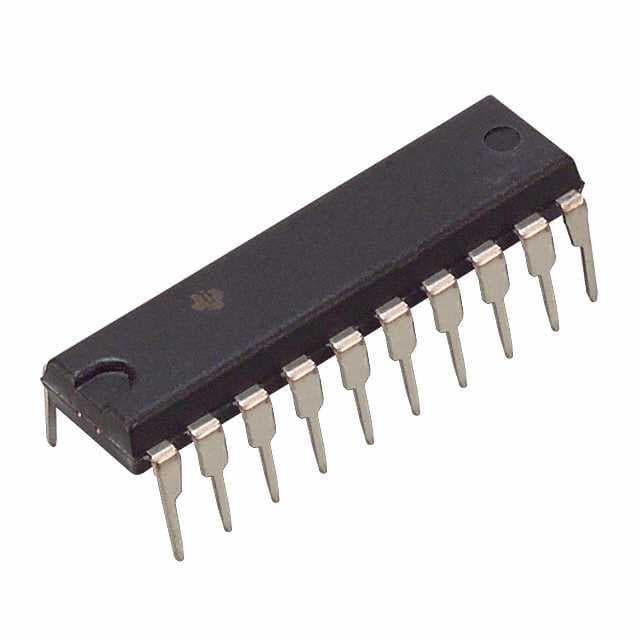Consulte las especificaciones para obtener detalles del producto.

SN74ALS1645AN
Product Overview
- Category: Integrated Circuit (IC)
- Use: Shift Register
- Characteristics: High-speed, TTL compatible, 8-bit parallel-in/serial-out shift register
- Package: DIP (Dual In-line Package)
- Essence: Serial-to-parallel data conversion
- Packaging/Quantity: Tube packaging, 25 pieces per tube
Specifications
- Technology: Advanced Low-Power Schottky (ALS)
- Number of Bits: 8
- Logic Family: TTL (Transistor-Transistor Logic)
- Supply Voltage: 4.5V to 5.5V
- Operating Temperature Range: -40°C to +85°C
- Output Drive Capability: 10 LSTTL Loads
- Maximum Clock Frequency: 100 MHz
- Propagation Delay: 9 ns (typical)
Detailed Pin Configuration
The SN74ALS1645AN has a total of 20 pins. The pin configuration is as follows:
- SER (Serial Data Input)
- CLK (Clock Input)
- GND (Ground)
- QA (Parallel Output A)
- QB (Parallel Output B)
- QC (Parallel Output C)
- QD (Parallel Output D)
- QE (Parallel Output E)
- QF (Parallel Output F)
- QG (Parallel Output G)
- QH (Parallel Output H)
- MR (Master Reset)
- VCC (Supply Voltage)
- QA' (Complementary Output A)
- QB' (Complementary Output B)
- QC' (Complementary Output C)
- QD' (Complementary Output D)
- QE' (Complementary Output E)
- QF' (Complementary Output F)
- QG' (Complementary Output G)
Functional Features
The SN74ALS1645AN is a high-speed, 8-bit parallel-in/serial-out shift register. It allows for the conversion of serial data to parallel data at a fast clock rate. The device operates on TTL logic levels and is compatible with a wide range of digital systems. It offers a maximum clock frequency of 100 MHz and has a low propagation delay of 9 ns.
Advantages and Disadvantages
Advantages: - High-speed operation - TTL compatibility - Easy integration into existing digital systems - Wide operating temperature range - Low power consumption
Disadvantages: - Limited number of output pins (8 bits) - Requires an external clock signal for operation
Working Principles
The SN74ALS1645AN works by shifting in serial data through the SER pin and converting it into parallel data at the QA to QH output pins. The CLK input controls the shifting of data from one stage to the next. On each rising edge of the clock signal, the input data is shifted into the first stage, and the previously stored data is shifted to the subsequent stages. The MR pin allows for a master reset, which clears all the outputs to a low state when activated.
Detailed Application Field Plans
The SN74ALS1645AN can be used in various applications that require serial-to-parallel data conversion. Some potential application fields include:
- Data Communication Systems: The shift register can be used to convert serial data received from communication channels into parallel data for further processing.
- Display Systems: It can be utilized to control LED or LCD displays, where parallel data is required to drive individual segments or pixels.
- Industrial Automation: The device can be employed in control systems to handle serial data from sensors or other devices and convert it into parallel data for analysis and decision-making.
- Test and Measurement Equipment: It can be used in instruments that require parallel data processing, such as oscilloscopes or logic analyzers.
Detailed and Complete Alternative Models
- SN74ALS1645A: Similar to SN74ALS1645AN but with different package options (SOIC, TSSOP).
- CD74HC164E: 8-bit parallel-in/serial-out shift register from Texas Instruments, compatible with CMOS logic levels.
- 74HC595: 8-bit serial-in/parallel-out shift register with output latches, commonly used in LED matrix displays.
These alternative models offer similar functionality and can be considered as substitutes for the SN74ALS1645AN based on specific requirements and availability.
Word count: 526 words
Enumere 10 preguntas y respuestas comunes relacionadas con la aplicación de SN74ALS1645AN en soluciones técnicas
Sure! Here are 10 common questions and answers related to the application of SN74ALS1645AN in technical solutions:
Q: What is SN74ALS1645AN? A: SN74ALS1645AN is a type of integrated circuit (IC) that functions as an octal bus transceiver with 3-state outputs.
Q: What is the purpose of SN74ALS1645AN? A: The purpose of SN74ALS1645AN is to enable bidirectional data transfer between two buses with different voltage levels or logic families.
Q: What voltage levels does SN74ALS1645AN support? A: SN74ALS1645AN supports voltage levels ranging from 2V to 6V, making it compatible with various logic families.
Q: How many channels does SN74ALS1645AN have? A: SN74ALS1645AN has 8 channels, allowing for simultaneous bidirectional data transfer on each channel.
Q: Can SN74ALS1645AN be used in both parallel and serial communication systems? A: Yes, SN74ALS1645AN can be used in both parallel and serial communication systems, depending on the application requirements.
Q: Does SN74ALS1645AN have built-in protection features? A: Yes, SN74ALS1645AN has built-in diode clamps that protect against overvoltage and undervoltage conditions.
Q: What is the maximum data rate supported by SN74ALS1645AN? A: SN74ALS1645AN can support data rates up to 20 MHz, making it suitable for high-speed data transfer applications.
Q: Can SN74ALS1645AN be cascaded to increase the number of channels? A: Yes, SN74ALS1645AN can be cascaded to increase the number of channels by connecting the output of one IC to the input of another.
Q: Is SN74ALS1645AN compatible with TTL logic levels? A: Yes, SN74ALS1645AN is compatible with both TTL and CMOS logic levels, providing flexibility in system design.
Q: What are some typical applications of SN74ALS1645AN? A: SN74ALS1645AN is commonly used in data communication systems, bus interfacing, level shifting, and general-purpose digital signal processing.
Please note that these answers are general and may vary depending on specific application requirements.

